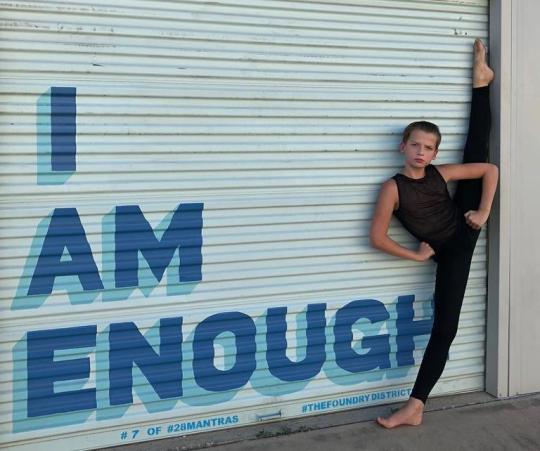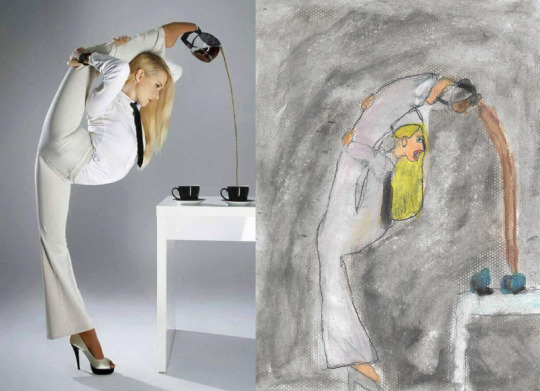#flexability
Photo

(via Pin by Brian M. Sabourin on YOGA-LL | Fitness, Yoga, Health and wellness || Curated with love by yogadaily)
#flexability#health#mindfulness#selflove#healthlifestyle#yogainspiration#fitnessmotivation#yogapose#eka pada raja kapotasana#yogabun#seaside yoga#yoga#yogi#yogini#yoga pose#yoga poses#yoga posture#asana#asanas#yoga inspiration#yoga motivation#yoga aesthetic#aesthetic#motivation#motivational#manifesting#manifest#manifestation#fitness#fit
35 notes
·
View notes
Text



Spooky spice
62 notes
·
View notes
Text



Suddenly, I'm interested in Yoga.
45 notes
·
View notes
Text
This what I think goes on through my students heads when I make them do a chaturanga push-up 🥲
#me#personal#selfie#picoftheday#yogaeverydamnday#sendnüdes#sendn?des#fitspo#flexability#brunette#self
52 notes
·
View notes
Text
Tea Time Emotiku
ADAPTABILITY, 05/15/2023
Flex ability / yes, adapt ability / Each is quite enough! © keefderpoet, 2023

“If you can’t fight and you can’t flee, flow.” Robert Eliot
It’s funny, but when I was younger, I would see how to do something and that’s how I would do it. Mentors would offer suggestions or ideas on how to do things differently or better, but I was resistant. Now that I am older, I see how many things can be done more effectively and efficiently. I can do things the way I’ve always done them, if I wish, but I can also take different paths and obtain fresh insights. Why did I fight learning as a young man? Now that I am an old codger, I love learning and just wish my body would cooperate more (lol).
4 notes
·
View notes
Text
IF YOU’RE GONNA WRITE SMUT, LEARN WHAT THE HUMAN BODY CAN AND CAN’T PHYSICALLY DO. IF YOU’RE CHARACTER IS FLEXIBLE WRITE IT INTO THE STORY, MAYBE THEY’RE A YOGA INSTRUCTOR OR THEY DID CIRCUS FOR A TIME AND HAVE KEPT UP ON THEY’RE STRETCHING ROUTINE, JUST WRITE IT IN! (Monster fuckers you are NOT exempt)
#writer problems#what am i even talking about#x reader#reading#bdsmkink#bdsmplay#bd/sm dynamic#flexability#biohazard#smut
4 notes
·
View notes
Text


I recently did a watercolor painting based on this picture of contortionist Julia Gunthel aka Zlata. I had lot of fun making piece especially figuring how to make work, I hope did Good Job this was a real challenge that I think brought out the best in me.
#Julia Gunthel#Zlata#watercolorpainting#watercolorillustration#hand drawn#traditional art#watercolor#colored pencil#flexability#flexable#contortionist#coffee#pouring a cup coffee#contortionism#gymnastics#high heels#side by side#comparison#streching powers#real life superhumans#handpainted#gymnast
5 notes
·
View notes
Text

It Feels So Good To Be Flexible
Learn How...Go Here
0 notes
Photo

Modern Closet - Flat Panel
Inspiration for a mid-sized modern gender-neutral ceramic tile dressing room remodel with flat-panel cabinets and white cabinets
0 notes
Photo

Happy Monday 😆 ps don’t forget to stretch 🦵🏻 #happymonday #dontforgettostretch #bendy #flexylegs #flexability (at Alkrington) https://www.instagram.com/p/CiZpAnYDZlE/?igshid=NGJjMDIxMWI=
0 notes
Photo

Have you ever noticed doing something good for some one else makes you feel better yourself? It's part of our DNA! In a world where you can be anything, be kind - you never really realize the difference in can make in 1 persons life... #fusionfitness #bekind #flexability #strength #balance #bettertogether #selfcare https://www.instagram.com/p/Cf_GPuUo02A/?igshid=NGJjMDIxMWI=
0 notes
Text
Your Fitness
I keep reading articles on how fitness can be determined by 3 things. The length of your stride, the amount of water you drink and watch what you eat. I'd like to call bullshit to this group of articles as a whole, because I've been doing a longitudinal study of ME and well other friends through social media, and none of their advice has helped determine how fit you are.
I'm not a twink by any means. I'm a bear. I'm considered a power bear because I lift heavy, I'm furry, and I have a belly. Please don't confuse me with being a whale. The difference between being a bear and a whale is the amount of extra weight hanging over your belt, and whether or not your stomach muscles can be seen. (See pics of me to confirm!)
But, mind you, I started out as a skinny farm boy that beefed up, and then in 2014 suffered an athletic hernia that has resulted in a dramatic reduction to my fitness. So, let's take a look at what I consider to be fitness and where I stand, in comparison to 2014.
What is Fitness
Fitness can be measured many ways, but the way I define it is .. The ability to do an activity for as long and as hard as you can .. This could be jogging playing soccer, surf boarding, boxing, grappling, or other activities. To work that hard doesn't rely on the length of your stride or how much water / gaitoraide you drink, or what you eat so much as it does with many other factors.
Your body is made up of slow twitch and quick twitch muscles that need oxygen and energy in order to perform at an optimal efficiency. How efficient that system is determines how fit you are. Can you body move oxygen from your lungs and lipids from your fat cells through your blood stream to your muscles and brain in order to have it converted into energy by the mitochondria? A process known as cellular respiration.
Some people's muscles require so much energy that they have two mitochondria per cell.
Now that we have a basic understanding of what needs to happen in the body for muscles to work over long periods of time, let's start narrowing in on a few things in this system that define how fit they are to carry out this process.
Heart Rate and Oxygen Levels
There is of course the heart. The 3 measures that determine how healthy the heart is without any further invasive testing are .. Heart rate and Blood Pressure. I said 3 .. Blood pressure has to measurements. A 4th indicator that is related to the lungs is your Oxygen level. To determine how the heart is doing, you need to measure these 4 on a regular basis as multiple points.
Upon waking
At rest / just sitting
While working out - at 2 points
Before bed
The change of these numbers of yrs of recording will determine which way your health is moving. The numbers can also be taking in regards to others in your age, sex, race, weight group to determine other significant factors. But, if you are recording these numbers alone, then determine which type of change is occurring .. no change, going down or going up.
There are 2 points to check your Pulse Ox Levels during a work out. The first is when you're working at your max. The second is when you're resting. You can monitor how fast the transition occurs as well. We will come back to this when I discuss recovery. But, for now, note that your heart has a max rate that it can pump at, and your diaphragm is made of muscle that will tire out based on use.
You'll notice that I post 2 to 3 pics of my tredmill workouts. They are my resting heart rate before I start working out, my resting heart rate when I've warmed up .. 3 - 6 mins and up to 100 breaths .. , followed by a pic of my max heart rate usually between 164 and 174, followed by a pic of my resting heart rate after the workout during a cool down of 100 breaths. The other thing I record is how many times I've attempted to jog or sprint on the tredmill .. which can be between 3 to 6 attempts. If the resting cool down heart rate doesn't drop below 125 then I call it quits on the tredmill due to level of effort my heart is working at to try and keep me jogging at a set speed.
Which loops me back to my initial point .. Do what you can for as long as you can ..
Activity Length - Stamina
How long can you do, what you do? Heart stress tests come in 2 forms .. Get on a tredmill and speed up your heart to it's max output, then do an ultrasound, or use a chemical to speed the heart up and do the ultrasound. I prefer the former, as there is less chance of heart failure and I can control the test and terminate it should things not feel right as I'm reaching my max cardiac output.
But Max Activity Length means how long can your muscles do what you are doing? I've played volley and wally ball for 3 hours at a time. But, I also take breaks between games to let my body recover. I could also roller blade up to 12 miles before my body would say enough.
Now, there is another Max Length to consider, esp for ADHDrs. It's the Max Length you can mentally withstand doing something that has no mental stimuli. This indicator will skew the results of the other Max Activity Length because you are not motivated to continue the activity, and your brains executive function will eventually give out. It's not the muscles giving out, it's the neurons that control the muscles giving out.
As an indicator, I used to be able to job 5 miles in high school. 3 miles pre 2014. And, now 1.5 miles 2022. But let's look at 2014's number again, as there is a gap in jogging. While I jogged in high school, that was roughly 35 yrs prior. So in 2012, I began biking 14 miles a day for work. That lead to me jumping back on the tredmil to find that I could not job for more than 50 breaths at a time. I worked to 100 breaths, 150 breaths, 200 breaths, 300 breaths, then 400 breaths, then jumped to 800 and 1200 breaths, with my max at 1600 breaths. Let's examine those numbers in context to fitness.
First, let's note that my legs were not trained to jog in 2012 when I started jogging again. They were trained for quick short reps of sprinting and jumping. They were trained for long bike rides .. 14 to 20 miles. But even then, I could rest while biking. To jog, esp on a tredmill is a constant, non-stop activity. There is no resting point. So, to be able to jog for longer and longer distances over time meant that my legs were just getting used to the new activity.
Now let's look at today, where I'm jogging in the range of 600 breaths at a time. That is 1/2 of my former average of 1200 breaths. Another indicator of my decline is the speed at which I'm jogging. I'm went from 7 mph at my top down to 5.7 mph. And, then there is my warm up speed which at one point dropped from 3.5 mph to 3 mph. Which raises the question, what changed?
First, I was the athletic hernia. I had to stop all activity in order for that to heal. That took years. My body's quick twitch and long twitch muscles changed as well. I probably lost the 2nd mitochondria. My lungs ability to exchange O2 dropped significantly. I gained 30 lbs. I had covid, and other issues respiratory issues due to construction dust.
Consider the impact of all that for a moment. I'm jogging 1 mph slower, breathing with 1/2 of my previous lunch capacity, carrying 30 more lbs of weight, and my muscles become exhausted faster as the needed sugars and O2 can't get to them fast enough. This can be restored, but at a much slower pace than has happened in 2012 to 2014.
Mobility, Flexibility, Stability, Balance
The next part focused on the secondary muscles that support the primary muscles. These muscles become involved in stabilizing the load or movement as you shift your weight. For example take weight lifters, they load 100s of lbs on their back and squat with it. Or do a Clean and Jerk to throw the weight over their head and stand upright with it. This requires the coordination of all the muscles in the body, as well as all of them working correctly to support the movement and load.
I read a book on running that said, "Running is a single leg activity!" I had to stop and think about that for a moment. And, technically it is true. If you watch a runner, like a horse, there are 4 distinct moments that the feet move through. 1st a foot is flat on the ground and moved to the back, at the moment it lifts off the ground the heal of the 2nd foot is preparing to hit the ground. For a split second, you are suspended in air. As the 1st foot / leg curl into the body, it travels to the front suspended in the air. Then, it extends, and the cycle repeats.
During the time that one foot is suspended in the air, your other foot is balancing your whole body. Every major and secondary muscle is working to keep you balanced. And should anything go wrong, you are suddenly grasping for the handle bars or guide rails to avoid becoming a splatter point on the treadmill.
So, to test and strengthen these points, we do balance excersizes. Or, we do cross training excersizes. For example, you will find weight lifters playing soccer. Why, you ask? Because, weight lifting doesn't involve movement, and soccer does. Thus, the secondary muscles are engaged to help strengthen them and train them on how they are supposed to work. This is why many foot ball players take ballet.
Flexibility is the ability of the muscle and joint to move in the direction its supposed to. As you get older and tendons become drier, (a medical term used to describe the lack of blood flow through the tendons which causes them to become less supple), your joints begin to tighten and refuse to move in the full range. I for example, can't put a bar over / behind my head due to how tight my shoulders are.
Another issue with mobility that many older adults start seeing is knee and hip issues. As described above with my shoulders, the hips at times have major pain issues from multiple points pulling very hard. I relieve this by doing pause squats and active stretching.
Swetting
While water intake is needed during a good hard workout, swetting is also very important. And, if you don't swet, you're not producing enough water in the cellular respiration process.
To use swet as a determination of how fit you are, you need to look at your activity load over a period of time. As you become less and less able to achieve the max load you used to, you will find it harder and harder to swet. Or, if you do swet, you won't swet as much.
For me, I've noticed that as my mobility declined as I gained weight and my O2 exchange rate decreased, I was not swetting as much as I used to. I call this, "Achieving Billy Goat Status" as the swet mark on my shirt looks like a Billy Goat.
A study showed that people who started swetting immediately when they worked out, indicated that their body was anticipating the heavy load and cooling requirements needed. While those that didn't swet were not reaching these maxes as easily or as often to trigger the swetting.
I have noticed that as my O2 exchange rate returns to pre 2014 levels, my ability to swet out my shirts has improved. Don't ask me what I smell like, as I think that was affected by the covid. But, I'm glad that I'm swetting more.
Fat vs Muscle Mass
Many scales today provide a BMI or Body Mass Index based on passing a electrical signal through your feet to see how the echo changes based on muscle, fat, bone and water content. And, here you thought it was just a simple galvanic skin response to an electrical pulse.
Many people are told that their weight is causing their phsycial issues, including me. You need to loose weight to stop snoring, or reduce your foot pain, or hip injury, or other ... Sure, I'll get right on that. But a more important factor is how much muscle you have to your body fat. As muscle will chew up body fat, the wider these 2 ratios are, but better your fitness level actually is, unless you drop below 18% body fat. Athletes can go lower, but even then, it's just for an event. Lower than 5% and you're risking serious damage.
So, when I say a wide gap, at my best in 2014, I was below 25% body fat, and above 45% muscle. I was jogging 3 to 4 miles every other day, rowing 1000 pulls at in 32 mins reaching 6400 meter, I was cycling 20 miles easily. I was grappling 3x a week. And, lifting upwards of 400 lbs in squats.
Oh, and from all this activity, my body weight was 205 lbs.
Summary
So what I consider fitness is the ability to do something that elevates your heart rate in intervals of work and rest for as long as you can. And, how well you can do it. The more you swet, the better off you are. It's not about your stride length, or what you eat. (Partially, what you eat! But even a teenager eats garbage and then does some amazing things physically! I think they call that carb loading???)
Fitness is the level of fat to muscle mass. Fitness is the number of mitochondria you have in your muscle cells. Fitness is being able to get out of bed and walk to the gym for an activity that will improve your mobility. (That was me yesterday on the stairmaster trying to get my hips to move.)
Fitness is a measure of where you are now, compared to where you were a year ago.
#fitness#working out#training#stamina#mobility#flexability#stability#02 exchange rate#heart rate#bpm#recovery time#muscle fatigue#cross training#quick twitch#slow twitch
1 note
·
View note